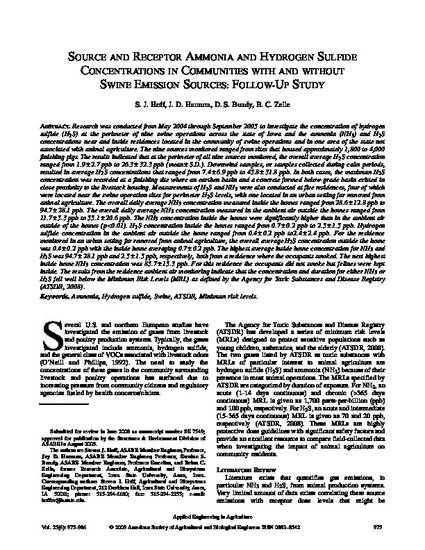
Research was conducted from May 2004 through September 2005 to investigate the concentration of hydrogen sulfide (H2S) at the perimeter of nine swine operations across the state of Iowa and the ammonia (NH3) and H2S concentrations near and inside residences located in the community of swine operations and in one area of the state not associated with animal agriculture. The nine sources monitored ranged from sites that housed approximately 1,800 to 4,000 finishing pigs. The results indicated that at the perimeter of all nine sources monitored, the overall average H2S concentration ranged from 1.9±2.7 ppb to 26.3±32.3 ppb (mean±S.D.). Downwind samples, or samples collected during calm periods, resulted in average H2S concentrations that ranged from 7.4±6.9 ppb to 45.8±31.8 ppb. In both cases, the maximum H2S concentration was recorded at a finishing site where an earthen basin and a concrete formed below-grade basin existed in close proximity to the livestock housing. Measurements of H2S and NH3 were also conducted at five residences, four of which were located near the swine operation sites for perimeter H2S levels, with one located in an urban setting far removed from animal agriculture. The overall daily average NH3 concentration measured inside the homes ranged from 28.6±12.8 ppb to 94.7±28.1 ppb. The overall daily average NH3 concentration measured in the ambient air outside the homes ranged from 11.7±5.3 ppb to 55.1±20.6 ppb. The NH3 concentration inside the homes were significantly higher than in the ambient air outside of the homes (p<0.01). H2S concentration inside the homes ranged from 0.7±0.2 ppb to 2.5±1.5 ppb. Hydrogen sulfide concentration in the ambient air outside the home ranged from 0.4±0.2 ppb to2.4±2.4 ppb. For the residence monitored in an urban setting far removed from animal agriculture, the overall average H2S concentration outside the home was 0.4±0.2 ppb with the inside home averaging 0.7±0.2 ppb. The highest average inside home concentration for NH3 and H2S was 94.7±28.1 ppb and 2.5±1.5 ppb, respectively, both from a residence where the occupants smoked. The next highest inside home NH3 concentration was 85.7±15.3 ppb. For this residence the occupants did not smoke but felines were kept inside. The results from the residence ambient air monitoring indicate that the concentration and duration for either NH3 or H2S fell well below the Minimum Risk Levels (MRL) as defined by the Agency for Toxic Substances and Disease Registry (ATSDR, 2008).
Available at: http://works.bepress.com/steven_hoff/83/

This article is from Applied Engineering in Agriculture 25, no. 6 (2009): 975–986.